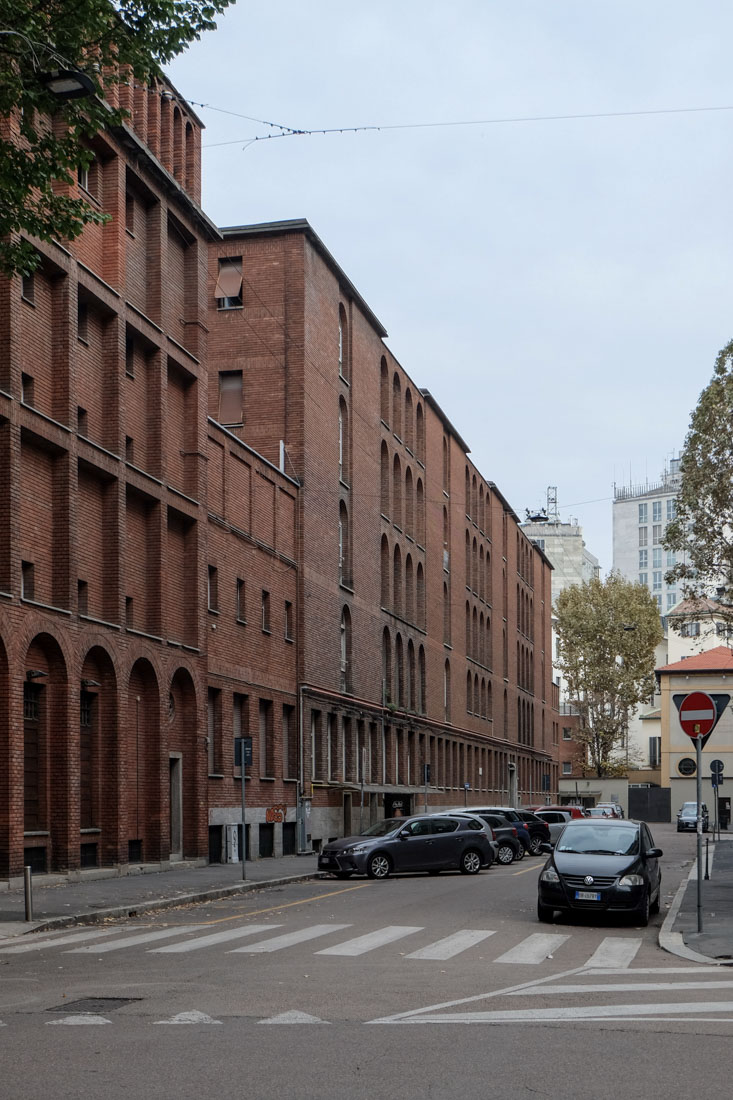 |
 |
 |
 |


Angelicum
Piazza S. Angelo 2, Milano
1939 - 1942
Between
1939 and 1942 the Angelicum in Milano was designed by the
renowned architect Giovanni
Muzio. The building complex is located on Corso die
Porta Nuova, not far from the historic city center. The
church that still exists today was the only part of the
former Franciscan monastery from the 16th century that was
spared from demolition. The monastery building was in a
desolate condition after being used as a warehouse and
military court since the suppression of the Franciscan order
in 1866. When the religious order again dealt with the
restoration of the church, there was a need for a larger
construction program. This included the construction of a
new monastery and a cultural center, the so-called
Angelicum. The Angelicum was to house a library for the
Franciscans with fifteen thousand books, a theater with six
hundred seats and numerous rooms for conferences, concerts
and art exhibitions. The actual monastery should consist of
the refectory, the kitchen, a small library, the classrooms
and around a hundred monastery cells. Due to the limited
space available for the Angelicum, the organization as a
compact volume was obvious. In contrast to the previous
monastery, which had two successive cloisters, the design by
Giovanni Muzio only features an elongated courtyard. This
cloister is bordered on one side by the side aisle of the
basilica and on the other side by the monastery. A low
portico runs around the cloister, consisting of columns from
the old monastery. Planted terraces are located above this
portico. The wing of the building along Via Bertoni is
completely occupied by rooms on the ground floor. The
monastery cells are on the upper floors. These are arranged
in a comb shape, with four volumes alternating with small
square courtyards. The courtyards facing the street are
articulated by a series of masonry arches arranged one above
the other. With this layout Giovanni Muzio responds to the
contradicting requirements. The inner courtyards serve to
illuminate and ventilate the cells, the acoustic influences
of the city are optimized by the comb-like arrangement and
the continuity of the facade ensures a unity in relation to
the public space of the street. The facades of the Angelicum
are completely clad with red-brown clinker bricks. The
entrance facade of the church, the monastery and the
Angelicum open to Piazza Sant'Angelo, a small church
courtyard with trees and the fountain of San Francesco.
Giovanni Muzio designed the new elements cautiously, so that
the basilica's effect comes into its own.
In
den Jahren 1939 - 1942 entstand in Milano das Angelicum nach
einem Entwurf des renommierten Architekten Giovanni
Muzio. Der Gebäudekomplex befindet sich am Corso die
Porta Nuova unweit des historischen Stadtzentrums. Die heute
noch bestehende Kirche wurde als einziger Bestandteil des
ehemaligen Franziskanerklosters aus dem 16. Jahrhundert vom
Abriss verschont. Das Klostergebäude hatte sich in einem
desolaten Zustand befunden, nachdem es seit der
Unterdrückung des Franziskaner Ordens im Jahr 1866 als
Lagerhaus und Militärgericht genutzt worden war. Als sich
der religiöse Orden wieder mit der Restaurierung der Kirche
befasste, entstand das Bedürfnis nach einem grösseren
Bauprogramm. Darin enthalten waren der Bau eines neuen
Klosters und eines Kulturzentrms, das sogenannte Angelicum.
Das Angelicum sollte eine Bibliothek für die Franziskaner
mit fünfzehntausend Büchern, ein Theater mit sechshundert
Sitzplätzen sowie zahlreiche Räume für Konferenzen, Konzerte
und Kunstausstellungen beherbergen. Das eigentliche Kloster
sollte aus dem Refektorium, der Küche, einer kleinen
Bibliothek, den Klassenzimmern und rund hundert
Klosterzellen bestehen. Aufgrund der beschränkten Fläche die
für das Angelicum zur Verfügung stand, war die Organisation
als kompaktes Volumen naheliegend. Im Gegensatz zum früheren
Kloster, welches zwei aufeinander folgende Kreuzgänge
aufwies, ist im Entwurf von Giovanni Muzio lediglich ein
langgestreckter Innenhof angelegt. Dieser Kreuzgang wird auf
der einen Seite vom Seitenschiff der Basilika, auf der
anderen Seite vom Kloster begrenzt. Rund um den Kreuzgang
verläuft ein niedriger Portikus, bestehend aus Säulen des
alten Klosters. Über diesem Portikus befinden sich
bepflanzte Terrassen. Der Gebäudeflügel entlang der Via
Bertoni wird im Erdgeschoss komplett von Räumen eingenommen.
In den oberen Etagen befinden sich die Klosterzellen. Diese
sind kammförmig angeordnet, wobei sich vier Baukörper mit
kleinen quadratischen Innenhöfen abwechseln. Zur Strasse
werden die Innenhöfe durch eine Abfolge von übereinander
angeordneten Mauerwerksbögen artikuliert. Mit diesem Layout
reagiert Giovanni Muzio auf die widersprüchlichen
Anforderungen. So dienen die Innenhöfe der Belichtung und
Belüftung der Zellen, die akustischen Einflüsse der Stadt
werden durch die kammartige Anordnung optimiert und die
Kontinuität der Fassade sorgt für eine Einheit in Bezug auf
den öffentlichen Raum der Strasse. Die Fassaden des
Angelicum sind koplett mit rotbräunlichen Klinkersteinen
verkleidet. Zur Piazza Sant'Angelo, einem kleinen Kirchenhof
mit Bäumen und dem Brunnen des San Francesco, öffnen sich
die Eingangsfassade der Kirche, des Klosters und des
Angelicum. Giovanni Muzio gestaltete die neuen Elemente
zurückhaltend, so dass die Wirkung der Basilika
uneingeschränkt zur Geltung kommt.